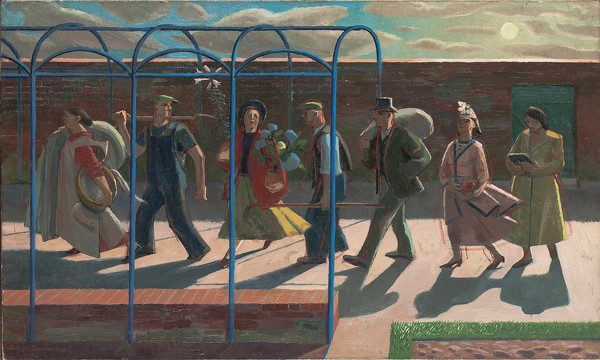

 Hover over the painting to magnify (there may be an initial delay while the magnified image is loaded)
Hover over the painting to magnify (there may be an initial delay while the magnified image is loaded)Evelyn Dunbar (1906-1960):
Seven Days
Framed (ref: 6719)
Signed and dated, inscribed on stretcher 'Design for mural'
oil on canvas. 18 x 30 in. (45.8 x 76.2 cm)
See all works by Evelyn Dunbar oil allegory 1.PORTRAIT OF AN ARTIST 2.dunbar 2022 49 pictures Dunbar catalogue Rediscovering Women Artist WOMEN Evelyn Dunbar at The Watts Gallery
Provenance: Roger Folley; Alasdair Dunbar; Hammer Mill Oast Collection
Exhibited: Corn Exchange, Rochester, May 1939; Evelyn Dunbar - The Lost Works, Pallant House Gallery, October 2015 - February 2016, cat 72.
Literature: Evelyn Dunbar - The Lost Works, eds Sacha Llewellyn & Paul Liss, July 2015, cat. 72, page 110, 112-113;
Llewellyn, Sacha, and Paul Liss. Portrait of an Artist. Liss Llewellyn, 2021, p.382.
Evelyn Dunbar: A Life in Painting, Christopher Campbell-Howes, October 2016, pages 238-240.
Seven Days, one of Dunbar's most intriguing - and powerful - allegorical paintings, has 'Design for a mural' written on the frame and scrawled on the back. Completed in 1938, it was exhibited in May 1939 at the Corn Exchange, Rochester, with this subtitle. What mural this refers to is not known. There's an unusual clue to its destiny as a mural design: several extraneous red transfer lines remain on the canvas. Which way should we read the figures? Left to right, the normal direction we read in, or right to left, following the group from the light to the dark, following the increasing length of the shadows? Does it matter? I think it does, maybe in the Kierkegaardian sense of life being lived forwards but understood backwards. On one level Seven Days is all about gardening, with one telling exception. Moving from left to right, Numbers 2 and 3 (the woman with the lily and hydrangeas), 4 and 5 all carry references to making things grow, to looking after creation, even at the level of the garden, in return, as is usual in Dunbar's work, for having been given it by the Creator. Number 6 sums up the benefits: she's carrying a basket of fruit, probably plums. Then Number 7, whom we can now confidently associate with Sunday, is reading, attending to things of the mind. Maybe it's her Bible, we don't know, but significantly behind her there's a door in the wall, maybe opening on to wider horizons and brighter truths. The top of the wall is strongly lit, suggesting that whatever lies beyond it basks in sunlight. On another level Seven Days is a personal statement. In preliminary sketches Number 1 is carrying a baby, her own particular harvest and promise for the future. Why did Dunbar change her to a woman carrying washing? Perhaps the answer lies in the fact that a little before the design of Seven Days was finalised Dunbar miscarried. The father was Charles Mahoney, her colleague and lover, formerly her Royal College of Art tutor. They weren't married. Their relationship came apart as her pregnancy was confirmed. The miscarriage and separation was a time of terrible misery for her, leading to what Dunbar called her 'crisis' years, which only ended with her 1940 appointment as a war artist. Christopher Campbell-Howes
We are grateful to Christopher Campbell-Howes for assistance.
 Unsung Heroines
Unsung Heroines Privately held
Privately held




